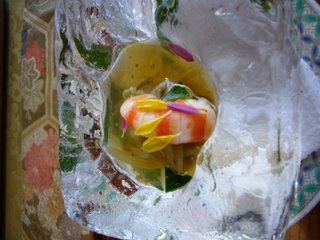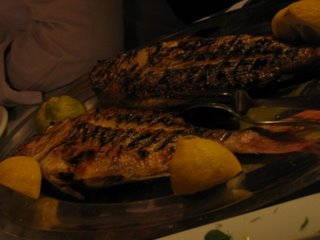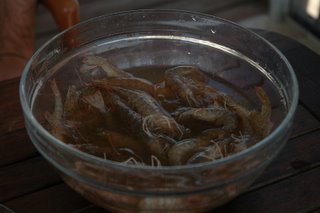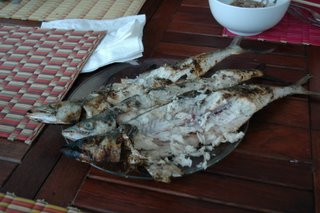Finally.
I found a definitive detailed explanation of fish handling from ocean to table with the necessary Japanese perspective, and it is very good. I have looked for this in every fish cookbook and fishing book I have ever seen. Thank you Bret!
The original article was posted by Bret on www.360Tuna.com,
the sportfishing community. I have kept his personal style, because I like it, but I have made some edits.
Bret acquired this information from a combination of being an obsessive/compulsive fisherman for over 40 years, chasing advanced degrees in marine oriented science to a dissertation short of a PhD, and about three years of informal apprenticeship under a master sushi chef.
Preparing the coolerPrepare your cooler with the smallest cubes available or even better, blown snow style ice. If you have larger cubes then it is best to make a saltwater slush by adding enough seawater (do this offshore, not in the harbor – clean water) so that it is easy to slide your fish in and submerge them as they are caught.
About adding salt to the water: It has been suggested that you should add rock salt to the mix to super cool it, but when tried you can end up with frozen fish. The extra high salinity cools the water below the freezing point of the fish and that isn't what you want.
Catching the fishThe next consideration is using tackle that will bring the fish in as quickly as possible. Fish biochemistry differs from humans’ considerably, but they undergo anaerobic respiration in their muscles when in "fight or flight" mode just like we do. That means that the longer they are on the string, the more lactic acid buildup you get with a proportional loss in food quality. It's like the poorly shot deer that has strong tough venison, well similar anyway.
Putting the fish in the boatOK, so we got the fish at the boat. It's decision time. Do you really want to sink that gaff into the loin where it will hold, or into the belly where you won't lose loin but it might rip out? The sushi chef doesn't like either alternative. On most fish the loin above the backbone is the meat and potatoes part of the fish but the belly is like caviar and escargot all rolled into one, especially in tuna (you see it as toro at the sushi bar, the most expensive cut of tuna). So, you take your time and stick him under the throat latch (a bad idea on sharks, they tend to want to swim right up into the boat when you do that, jaws snapping).
Put the fish in the coolerOpen the cooler and swing the fish into the box in one motion. No posing for photos yet. The fish won't like the ice one bit as you know, but the slush will give and not provide him anything to bang against, which reduces bruising tremendously. It has the same benefit on the ride home if you're pounding into a chop. The slush also makes contact with the fish over 100% of its body and thus chills him a whole lot faster than cubes with air spaces between.
Bleed the fishAs soon as you think the fish has chilled enough to be calm, but not dead, take him out and bleed him by cutting that throat latch right where it widens into the body. The fish's heart lies right behind that cut and the biggest artery in the fish runs between the heart and gills so this will empty him fast if his heart is still beating. You'll conserve ice if you can bleed him out of the ice chest (I have a bait well by the box that drains out of the boat and it works great for this), but if you bleed him into the box it isn't critical.
All fish benefit from this by the way, not just tuna, mackerel and sharks. It's more important on scombridae (mackerels, tunas, bonitas) and sharks for various reasons. It's needed on tuna and billfish because they maintain their body temperature higher than their surroundings so bleeding removes heat fast, on mackerel because they are very bloody and will taste strong if you don't bleed them and on sharks because they carry urea in their blood to help balance that osmosis problem and it breaks down into really nasty ammonia-like compounds right after death.
Killing the fish – Another waySpiking and Pithing – from a post by Peter Howgate, http://www.megapesca.com/peterhowgate.html.
Spiking is the process of destroying the brain by passing a spike through the skull into the brain. Spiking renders the fish unconscious so that it does not struggle and a similar effect is caused by giving the fish a hard blow to the head, a method of stunning farmed salmon on harvesting. Though the fish is rendered irreversibly unconscious by spiking or by stunning, all muscle activity does not cease. The muscle at least twitches, if not occasionally flaps.
Pithing goes further than this and is the process of inserting a wire into the spinal column of the fish to destroy the spinal cord either through the skull after spiking or from a deep cut through the vertebral column behind the head. Pithing stops all muscle activity. The various methods of killing fish, or letting fish die, affects the time taken for the fish to enter rigor mortis, and to some extent the time in rigor.
I shall not try to summarize the biochemistry of the rigor process and the way the killing methods affect the biochemistry, but pithing does maintain glycogen levels in the muscle. It should be noted that when different methods of slaughtering fish are compared, all of the glycogen is ultimately converted to lactic and the post rigor pHs of the flesh are the same; what is different between the killing methods is the time course of the glycogen depletion and lactic acid formation. (FYI: glycogen is the substance that is formed when an organism takes in more calories than it burns. It's like a fat precursor and its abundance elevates the quality of the meat.)
[Another post from www.360Tuna.com suggests this method for pithing: Cut a triangle hole on the back side of the head and then use an old truck antenna (fixed, not telescopic) and run it down the spinal cord.]
Delaying the onset of rigor is important for some uses, for example, for sushi products, so there is an advantage in pithing fish. For other outlets, for example, production of fillets, there is no advantage, and some disadvantages, in delaying the onset of rigor.
Where the effects of killing methods on subsequent spoilage have been studied, there has been no effect of killing method on storage life.
GuttingAfter you are satisfied that he is bled out gut him, but don't cut through the throat to the gills on bottom fish. That part is too valuable on snapper, grouper, amberjacks, etc (more on that later). It's not such a big deal on pelagics.
Put the fish back in the coolerOnce you have all this done slide the fish back into the slush so that the body is in a vertical swimming position with its head down like it is swimming for the bottom of the cooler. This allows any other loose body fluids to run out of the fish at your cuts instead of pooling in the meat and it helps to further reduce bruising on the way home.
Big fishIf you were really lucky and the fish was a beast that won't fit in the box, cut off the tail before the head. The tail meat is the least desirable on the fish. You'll notice that when you go on charters out-of-the-country and ask for some fish to take to a restaurant or whatever, the mate will almost always give you the meat from behind the dorsal fin to the tail unless you specify otherwise. Those guys know what they're doing and they're gonna keep the best for themselves or to sell at a higher price.
If you still have to remove the head (lucky you) then make doubly sure that you have either made a salt water slush or if you had crushed ice that the cooler is drain open for the rest of the trip. The meat above the backbone up by the head is the best block of meat on the fish (there are arguments on this between belly and loin men). It's not anatomically the same as the tenderloins on a deer but qualitatively they are analogous so you don't want it screwed up from freshwater ice melt.
Freshwater cautionFreshwater contact can mess up your fish faster than anything else if you're not careful. Fish skin acts as a natural barrier to the evils of osmosis so as long as it is there you're OK. Expose the meat to that freshwater unprotected and within seconds freshwater runs into the cells and explodes them like overfilled water balloons. There goes your tasty fish, and how much did it cost per pound? OH MY!
If you make a slush that has a similar salinity level to fish fluids, then the power to the osmosis engine is cut off and your fish is safe. If a little melt dribbles over the fish on the way to the bottom and out the drain its way better than having your fine cuisine soaking in it for hours.
At the dockIt has been a long hot day of fishing and you're finally back at the dock with a box of fish. Now you can drain all the saltwater out of the box so you won't get a hernia lifting it out. We'll assume a perfect world here and you are able to get your fish to the table easily and there isn't anybody else anywhere around.
As you approach the table a half dozen sleepy seagulls that have been roosting on the table take wing, each of them depositing a nice oyster sized glob of processed gull food right where you'll be cleaning you catch. There are gulls even in a perfect world. There are tap water hoses for you to rinse you catch and several lengths of 2X8 lumber to use as cutting boards.
Obviously, if you are thinking about eating your fish raw there are some things here that are unacceptable. The provided cutting boards have been in use for who knows how long and cleaned up with a minimum of care, if at all, for as long as they have been in use. The gulls have probably never left a deposit on them either, right? The point is, the cleaning table should only be used for the preliminary cleaning that you really don't want to do at home.
Dockside cleaningStep one is to decide how the fish will end up. Most of the time we don't even consider options other than fillets, but in the world of haute cuisine this is the least desirable form. Fish cleaned with skin and bone intact hold better, freeze better, give you more options later and if you cook them, they yield a much moister tastier product than boneless skinless fillets.
Optimally all you do at the cleaning table is gut the fish (if you didn't do it at sea), scale, and rinse them. Even here you can make a difference though. Just take the fish out of the box and work on them one at a time and then put them back in the ice. You went to the trouble and expense of all that ice to keep your fish cold so don't waste it by piling the fish on the table to get hot while you work. You'll get some funny looks for scaling your fish, but it's a little like having numbers to a spot that nobody else has. Just smile and keep working. That's all you want to do here. Everything else occurs in a way more sanitary environment, like your kitchen.
Meat aging and storageThe good news is that your fish are now in a kind of suspended animation in terms of quality and as long as you keep them vertically on drained ice, they will actually improve for three days. So, you can get all the rest of the chores done and rest up some before you become a bona fide fish butcher.
I probably ought to explain that 'improve for three days' thing. The old saw, "Fish are best right out of the water", is a myth. Fish is protein just like lamb, beef, pork or venison and all those proteins benefit from aging as we all know. So why not fish? The molecular structure of fish protein is slightly different from mammals, but it still improves with proper handling.
The fish need to be kept on ice, not in the refrigerator, and held in that same vertical position to allow draining. Tip the ice chest so that it drains most efficiently and add ice to keep the fish covered as necessary. Like this, fish improve to the end of the third day after capture and then hold there for 24 hours before beginning to decline in quality.
If I haven't eaten the fish by the fifth day, they get frozen. This is an average for all fish. The process is slightly faster for dolphin and slower for snapper. Tuna are the benchmark for this system. Tuna sashimi right on the boat is good if you eat it still "dancing" with life, but if you wait until the fish is stiff before slicing, it will be the toughest sashimi you ever eat.
Regarding ice versus the refrigerator: Ice stays the same temperature, refrigerators do not. It might be a picky difference but remember that this is one of those Japanese precision things. Ice is just better.
And then there's the plastic bags touching the fish thing: That is supposed to cause a problem due to lack of oxygen exchange, but I don't have any data to support it. Sushi chefs usually wrap their fish in paper and then plastic over that if necessary.
Regarding the bacteria breakdown aging thing: I wondered about that too but I never looked it up until now. The bacteria is only involved in creating the crust on the outside of dry aged meat. The tenderizing comes from enzymatic action on the actin/myosin complex muscle fibers (proteins breaking down other proteins).
Cleaning for the tableThe fish come out of the ice one at a time and get rinsed in tap water for the last time. Now they are thoroughly dried with paper towels. You'll be amazed at the difference in cutting up dry fish vs. wet. Done right, you will not even feel the slightest urge to wash the meat. It will be cleaner than any you've done before.
If you don't get the fish dry and you get a little goop on your fish, mix up some salt water (about a tablespoon per quart) with plain salt and bottled (not tap) water and you can wash them without the burst cells problem.
Cutting for the tableAnyway, the first item is to remove the head, but sushi chefs take off a lot less than we normally do. The cut runs from the top of the head down in front of the rear gill collar down to the throat latch that you already cut when you bled the fish on the boat. Now is the time to remove those cheek scallops from the head that are so popular and then discard the rest of the head.
Next it is time to remove the belly pieces and throat. After you have done this a few times this step is pretty simple with just a knife, but the first few times through you'll be happier if you have some heavy duty kitchen/game shears or tin snips for snapping the gill collar at the backbone. Start cutting the belly back by the vent and work forward along the bottom of the backbone, through the ribs until you run into the juncture of the backbone and gill collar. This is easy with a serrated knife. There really is a little seam there that allows you to complete the cut with your knife, but like I said it usually takes a few practice runs before you are comfortable with it. So, get out your shears and snap it off next to the backbone. Now repeat this on the opposite side.
You'll end up with a giant butterfly looking piece of meat and just how giant the butterfly is determines your next move. Just keeper snapper, small grouper, redfish and the like can keep this whole. All you do is make a cut on the inside of the throat on the midline so that the butterfly wings lay flat. This meat will have bones, most of them large and easy to get around but you'll have to warn the family members used to fillets.
The reward is outstanding fish and that is not overstating the claim. These areas of the fish do the least work but store the most fat. Just like a well marbled prime rib this is really good stuff grilled, fried or broiled (on bottomfish, mahi and wahoo.
For most amberjacks split the collar into 2 halves, they're too big to handle as one piece. This section is the Gulf equivalent to a Japanese classic done with their 8 to 12 pound yellowtail (same genus, different species from amberjacks) called the hamachi kama. Hamachi is yellowtail and the kama is the collar section with a little of the front part of the belly attached.
Just don't toss the kama word around too loosely without a fish name in front of it. By itself, kama is Japanese slang for gay, so in the wrong crowd you might make a sumo wrestler pretty unhappy with you! The rear part of the belly on yellowtail, or amberjacks is reserved for high quality sashimi.
OK, now we've got the carcass trimmed down to the basics and the rest is pretty much what you have always done. The sushi chef has a ritual of slicing the length of the fish just under the skin along the dorsal fin on one side then along the anal fin and then along the anal fin on the other side and finally the opposite side of the dorsal. There's a name for that technique, but it has flown out of my brain for the moment.
They then retrace their steps completing the cuts down to the backbone and finally removing the fillets where they attach to the backbone by pretty much just lifting them off.
On small fish like flounder and just keeper trout the backbone is broken in half and then marinated in a combination of soy and sake and then deep fried for an appetizer. Sounds weird but I have had guests turn down entrees for more "fried bones!"
Larger fish have the remaining flesh removed with a teaspoon and this is mixed with minced scallion and some nanami togarashi (Japanese 5 spice) or other ingredients and used as a filler for makizushi (rolled sushi). There's not much left for the garbage guys to haul off.
Tuna are more involved due to their roundness, but it's not that big of a deal. Make an additional cut the length of the fish down its lateral line so you end up with 4 loins instead of 2 fillets. Remove the blood line (your cat will love you) and you are good to go.
If you plan to work on sushi and sashimi for several days on a large fish, only cut off the carcass what you need for that session. Cover your fish in parchment paper and then plastic wrap and return it to the ice and you're good to go the next day.
Long term storageAs for freezer storage, you can't beat vacuum sealers. I use a Foodsaver Pro that I've had for over 15 years and the darn thing is still going strong, hope I didn't just jinx it! I have grilled year old blackfin stored that way next to month old blackfin and been unable to tell the difference, they're that good.
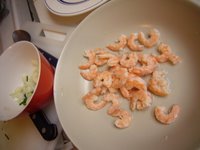

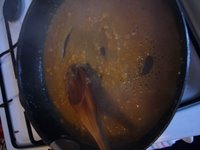
 You know, finding a half-full crate of supermarket prawns in the fridge is quite traumatic. First of all, it's the raw shrimpy smell wafting out from the crumpled platic bag balanced on top of the three-day old cheesecake and the chimichurri sauce. I needed to somehow cook the damn thing before it died, and I didn't want to make a shrimp curry once again. So there's only one thing to do: make bisque. I started promptly butter-sauteing the shells, and then pouring water in with the appropriate amount of herbs and reducing it down to a tasty roux. The result of a hour's work was a thick, beautiful bisque that then I lapped up in three minutes flat, with all the shrimp.
You know, finding a half-full crate of supermarket prawns in the fridge is quite traumatic. First of all, it's the raw shrimpy smell wafting out from the crumpled platic bag balanced on top of the three-day old cheesecake and the chimichurri sauce. I needed to somehow cook the damn thing before it died, and I didn't want to make a shrimp curry once again. So there's only one thing to do: make bisque. I started promptly butter-sauteing the shells, and then pouring water in with the appropriate amount of herbs and reducing it down to a tasty roux. The result of a hour's work was a thick, beautiful bisque that then I lapped up in three minutes flat, with all the shrimp.




